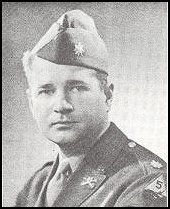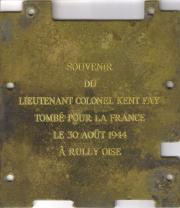use your browser back button to return
(Click on photos for larger view)In Memory of
Lieutenant Colonel Kent Fay (9/7/09 - 8/30/44)
(Editorís foreword)
Lt. Col. Kent Fay was commander of the 85th Cavalry reconnaissance squadron (tanks) which was part of the 5th Armored Division within General Pattonís Third Army. After landing at Utah Beach during the Invasion of Normandy on June 6th, 1944, the troops assembled in the forests and fields in lower Normandy. In mid July, some 156,000 troops began their breakout into central France led by Kentís reconnaissance tanks. An account of the 85thís progress through France toward Germany and the jubilation of the liberated French people that they encountered is detailed in Richard S.Gardnerís Paths of Armor
(the following text has been extracted from emails from Judy)
I think I mentioned that I went to France in 1999 and thanked the people of the little French village (Rully) who held a vigil in their church over my father's body before they were able to return him to the US Army. I talk about that experience to any group that will listen but mostly to Veterans Organizations and the like. This year I will tell the story to our church on a Sunday and thought I might incorporate this video clip (Before You Go) at the end of my talk. Have you seen it?
<<<<<>>>>>
I've been trying to write the story of my going to France since the day I got back. Just can't seem to get it in a place in my head where I can come from. My sister got so annoyed at me for stalling she got a writer from Atlantic Monthly all fired up about writing it. But when I wouldn't part with the emails and all the things that are needed, and screamed like a banshee, she backed off. After nine years, I can only tell it, but I think I am selfishly clinging to it myself as in, it's my story and I'm sticking to it, I guess. If we have another reunion I will tell it but not to the whole group, just those interested and able to sob in public.
It's really like I have to tell it to make it real still. You have to be willing to put your feelings back into that time. Patriotism, sacrifice and liberation. My father was a Lt. Col., reconnaissance, tanks, headed one of the two divisions that Eisenhower allowed to accompany de Gaulle when he asked for American troops to go through Paris on Liberation Day. I see him on one of those tanks in an old old newsreel waving and laughing. I never thought I would ever know that father until I stood on the exact spot on the dirt road in the little village of Rully in 1999. I was still as angry at him at age 59 as I was at 4. When I saw the French villagers also standing there crying and waving their flag and our flag and saw in the small print on a monument that marks that spot where it says 'Lt. Col. Kent Fay liberator of France'. Then I got it. Not just my father but everyone of those guys is a great American hero. Certainly not the reason they went over there.
<<<<<>>>>>
Rully is about 50 miles northwest of Paris, about 8 miles from Senlis. After the liberation march through Paris (8/28/44), my father spent two days right outside of Paris 'tuning up the tanks' and then got orders to proceed to Germany. They stayed in Senlis the night before he was killed.
The priest I am talking to in this photo, taken right outside of the church in Rully (4/24/1999), says he remembers seeing my father in the Senlis town square on that day. Father Geigo ( now priest in Rully) does not speak English so he did not talk to my father. He wanted to tell him thank you as his brother was being held in a Polish prison. (He died there.) The other priest is Rev. Antony Brown, a priest at St. Michael's church in Paris. He answered my email sent out into cyberspace asking for help in locating the church. He and his wife now live in Bristol, UK and Rodger and I visited with them in 2002. The man in uniform is my son Lt. Col. Joel Wilson who was stationed in England during this time. That's my granddaughter Kaitlyn and the children and wives of the farmer that took his body to the church. We even found the American driver of the Jeep that stopped for two French peasants just outside of town on the 31st. They were instructed not to stop as Germans would dress as locals in order to kill them. But they stopped anyway and were told that they had an American officer's body at their church.
As this picture was being taken, the church bell was tolling and most of the villagers were standing in the courtyard to welcome us. I walked about another 50 feet overcome with every emotion known and unknown. An old old lady with tears at full flow literally threw herself at me. Sheila Brown, also sobbing, translated that she was telling me that when she was 18 she had knelt by my father's body as part of the vigil they declared and that he was 'a handsome man.' He would have been 35 a week later.
Later that day there was a wonderful reception at the town hall with wine provided by the Mayor and hampers of chocolate brownies and cookies baked by Kaitlyn and I at her house (old RAF housing now US military housing) in Ely England. The brownies and cookies brought across the English Channel by chunnel, not landing craft. We cried and laughed, drank and screamed at each other in two languages as if if we yelled loud enough we would understand each other. Besides my son and his family my nephews Kent Lyons 23 and Phillip Thompson 17 also flew over for the day. All of my father's youngest grandson's got to go.
The man in the dark suit in front is Maurice, oldest son of Etienne. Maurice died this year in Senlis. Etienne (Stephen) died in 1979.
(photo of the brass plate that was inside the envelope)
At the reception Maurice presented to me a thick white envelope.When Antony Brown went out to meet these exceptional people, Maurice went down to his workshop in the basement and brought up this piece of brass. He told Antony when he was 14 he had used his pen knife to remove this radio plate from the tank. The tank burned and was left for many years right outside of the village right where my father died. He asked Antony if Madame Judy would like to have it.
This whole thing is so surreal, that I feel like if I could do this, everything is possible. My family teases me about being able to find just about anyone and at times I believe them. When my father was killed, he was wearing two pearl handled 45's that the German's took from his body according to Maurice. On days when I have this wonderful feeling of it's okay to be the daughter of an American hero, I think about starting a search in Germany to recover them. Well,,,, you know that's where they might be. :)<<<<<>>>>>
I think the website is a perfect gift of thanks to my father and all involved. If I had not sent that email out there to start it all off there would have been no end to the story. I would have always thought that my mother's telling me that little French children put flowers on your father's body just another widow's pipe dream. But it was true. I would have spent my whole life thinking that my father had committed suicide and left me on purpose. I was told as early as I have memories that he knew he was going to die if he got in that armored car to lead that unit into that French village. I thought an armored car was like a heavily plated Mercedes like generals rode in. When I got there and they showed me pictures of a burned out tank I realized the truth. An armored car is a tank with tires. Even I, the most cautious of girls, would have gotten in a tank. He took a risk for all the right reasons and he lost. He never left me at all. They told me as I was growing up that God took my father because he was such a good man. That didn't do much to endear God to me or me to God. When Mayor Guiliani told the orphans of 911, "Your father hasn't left you. Your father is always inside you," they were the first words of comfort that made sense to me in fifty years.
But this is not about me; it is about all our fathers. What a great bunch they were, huh?
(Editor's Footnote)
Lt Col Kent Fay now rests in the Epinal American Cemetery and Monument in France. The cemetery is 48.6 acres in extent and is sited on a plateau 100 feet above the Moselle River in the foothills of the Vosges Mountains. It contains the graves of 5,255 of our military dead, most of whom lost their lives in the campaigns across northeastern France to the Rhine and beyond into Germany. The cemetery was established in October 1944 by the 46th Quartermaster Graves Registration Company of the U.S. Seventh Army as it drove northward from southern France through the Rhone Valley into Germany.
(footnote photo and description taken from the American Battle Monuments Commission website)
Some more photos and background information from Judy - Click Here

